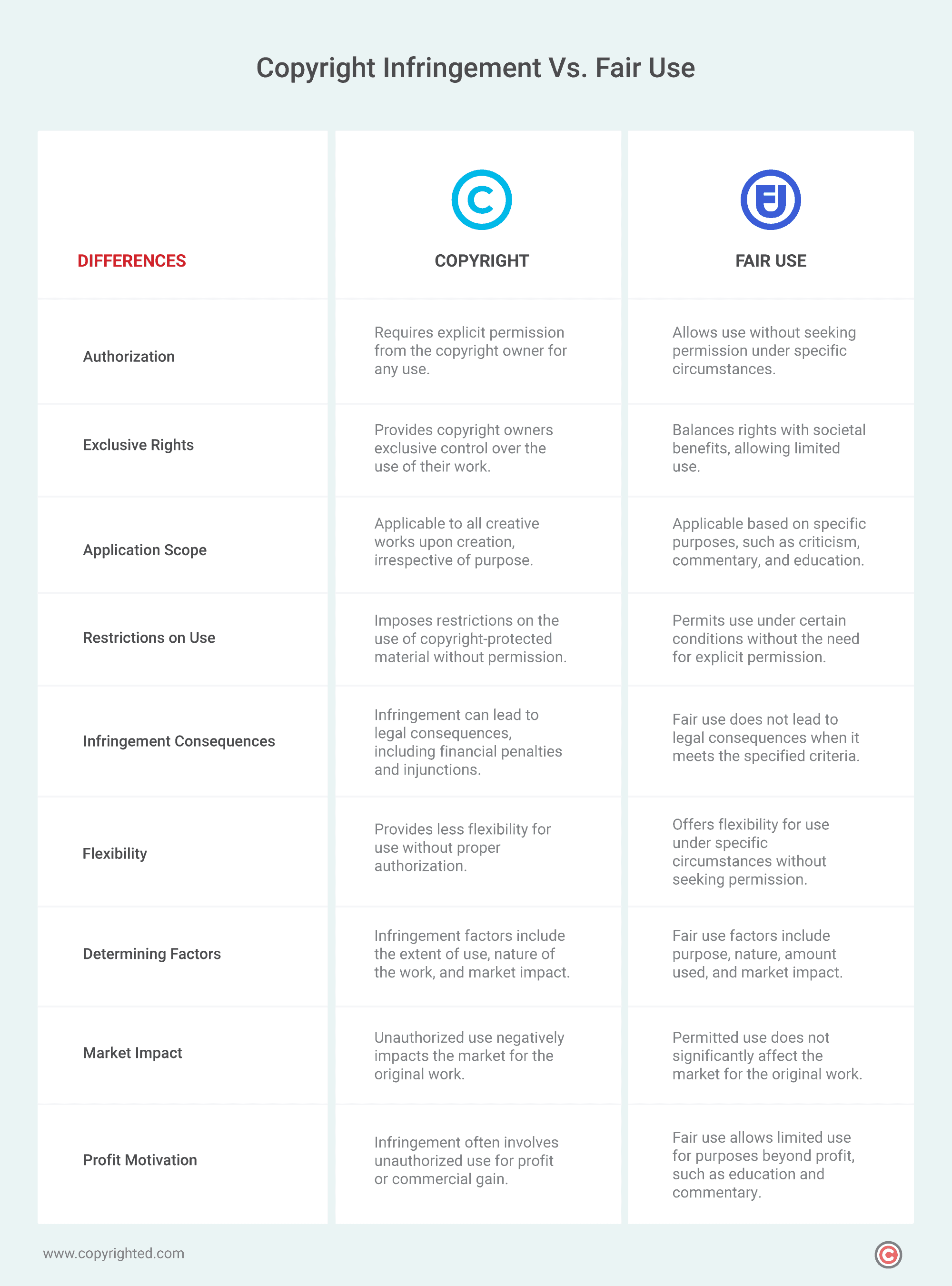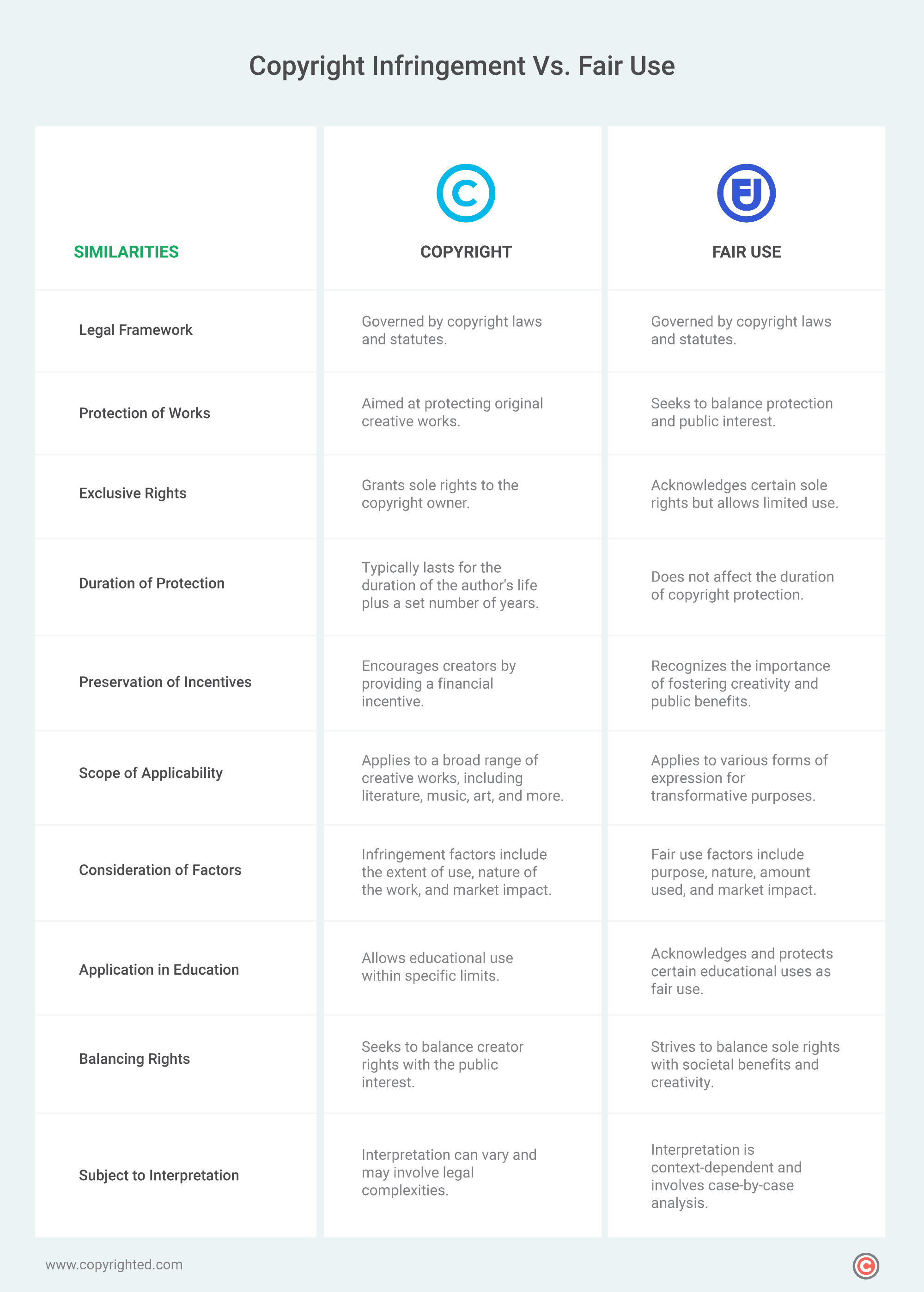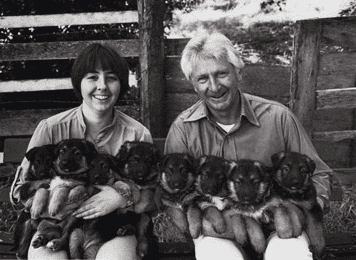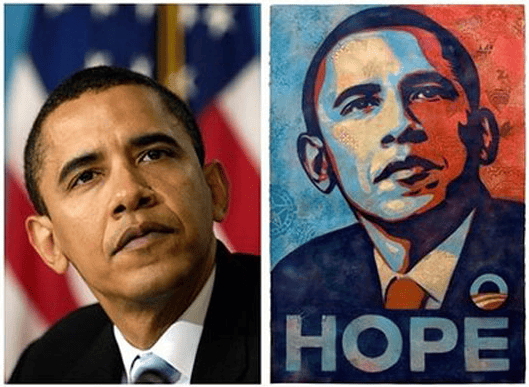Copyright and fair use often cause confusion due to their striking similarities.
The subtle distinction between these two concepts can be rather ambiguous, posing a challenge for individuals with limited knowledge of copyright to differentiate between them.
Comprehending the concepts of copyright and fair use is an important aspect for both creative individuals and business proprietors. This understanding ensures a clearly defined path through the intricate realm of intellectual property.
So, this article is here to help you understand the clear features, differences, and similarities between copyright and fair use. This way, you can easily grasp and use them in your creative projects.
- Copyright infringement occurs when copyrighted material is used without authorization from the owner, violating the sole rights granted by copyright law.
- Fair use allows the use of copyright-protected material under specific circumstances without seeking permission from the owner of the copyright.
- Unlike copyright licensing, fair use does not require formal permission, offering a more flexible option under certain circumstances.
Table of Contents
What is Copy Infringement?
Copyright infringement happens when someone uses, reproduces, or shares content protected by copyright without the owner’s permission.
In simpler terms, using someone else’s work without the proper authorization means violating the copyright law.
The infringement isn’t just limited to copying the material word-for-word; it includes any use that violates the rights granted to the copyright owner.
This often raises the question: Does copyright infringement require an exact reproduction of the original? The answer is no. Substantial similarity or unauthorized use of even part of a work can qualify as infringement.
This could involve reproducing significant parts of a text or distributing copyrighted content without the necessary approvals.
Getting involved in copyright infringement can result in serious legal consequences, ranging from financial penalties to court orders preventing further use of the material, and in extreme cases, criminal charges.
The severity of these consequences depends on factors like the extent of the infringement, its financial impact on the copyright owner, and whether it was intentional or unintentional.
To avoid legal trouble, it’s always safer to get proper authorization before using or sharing copyright-protected material.
What is Fair Use?
Fair use, outlined in Section 107 of the Copyright Act of 1976, is a legal concept that allows you to use copyrighted works in certain situations without the need for the owner’s explicit permission.
This legal principle eases up the strict interpretation of copyright law, which could otherwise hinder the creativity the very law aims to encourage and promote.
Fair use allows you to use and build upon existing works without unfairly taking away the original copyright holder’s right to control and profit from their creations.
Under fair use, you can use copyright-protected materials without violating the rights of the original holder. This is especially relevant when the use has a transformative purpose, like criticism, commentary, news reporting, teaching, scholarship, or research.
The essence of fair use lies in its encouragement of the exchange of ideas and the development of new content. It also recognizes that certain uses of copyright-protected material contribute to the greater good without undermining the economic interests of the copyright owner.
However, it’s important to understand that determining if a particular use qualifies as fair use is not always straightforward. Courts usually consider factors like the purpose and character of the use, the nature of the copyrighted work, the amount used, and the impact of using the original work.
In essence, fair use acts as a safeguard for the principles of free expression.
Yet, like any legal concept, the application of fair use can be context-dependent, often necessitating a careful investigation of the specific circumstances surrounding each use, including the effect of the use on the original work and its potential impact.
Copyright Infringement vs. Fair Use: What is the Difference?
Copyright infringement and fair use are two distinct legal concepts within the framework of intellectual property, each serving unique purposes.
The primary contrast lies in their impact on the rights of the copyright owner.
Copyright infringement takes place when someone uses copyright-protected material without obtaining the owner’s permission. This unauthorized use, if proven, can lead to legal consequences ranging from financial penalties to criminal charges.
On the contrary, fair use is an exception to copyright law that allows the use of original material under specific circumstances without seeking permission.
Fair use is a defense from copyright infringement. Its purpose is to balance the rights of the copyright owner with the broader benefits of creativity, commentary, education, and other transformative purposes.
Here is a table discussing copyright infringement and fair use differences:

Despite their contrasting nature, there are also notable similarities between copyright and fair use. They share some common ground in their consideration of factors such as the purpose of use, the nature of the copyrighted work, the amount used, and the impact on the market for the original work.
This table provides an overview of copyright and fair use similarities, emphasizing their shared role in the realm of intellectual property.

Copyright Infringement Determining Factors
When assessing copyright infringement, several key factors come into play, giving a comprehensive view of whether unauthorized use has occurred. These determining factors are important in establishing whether you’ve crossed the boundaries set by copyright law.
Extent of Use
If a large or important part of a copyrighted work is reproduced, utilized, or distributed without proper authorization, it raises concerns.
For instance, copying a significant portion of a copyrighted image, text, or audiovisual content may signal potential infringement.
In a famous copyright infringement case, photographer Art Rogers sued renowned artist Jeff Koons for using his photograph without permission.


Koons claimed fair use by using parody to create statues inspired by Rogers’ image. However, the court dismissed this defense, pointing out the significant similarities and suggesting that Koons could have conveyed his message without directly copying Rogers’ work. Consequently, Koons was required to make a financial settlement to Rogers.
Nature of the Work
The nature of the copyrighted work itself plays a role in infringement considerations.
Highly creative and original works, such as intricate illustrations, complex literary pieces, or unique music compositions, receive stronger protection. Infringement claims may be more significant if the unauthorized use involves these types of works as opposed to more factual or informational content.
Impact on the Market Value of the Copyrighted Work
If the unauthorized use negatively affects the market for the original work, it is likely to be seen as an infringement. This impact can be economic, reducing potential sales or licensing opportunities for the copyright holder.
For example, reproducing and distributing a copyrighted work may diminish or increase the market demand for the original.
In a case involving street artist Shepard Fairey, he created the iconic Hope poster during President Obama’s 2008 election campaign.
The image, based on a photograph by AP freelancer Mannie Garcia, prompted the Associated Press to demand compensation.

The Associated Press photograph of Barack Obama and Shepard Fairey’s “Hope” poster from NY Times
Fairey defended himself with a fair use argument, asserting that his work didn’t diminish the original photograph’s value.
Eventually, Fairey and the Associated Press reached a private settlement in January 2011, which included a profit-sharing agreement for the artwork.
It’s important to note that each case is unique, and the interplay of the different factors can vary a lot.
Fair Use Determining Factors
Understanding fair use involves considering four factors that help determine whether the use is fair under this exception.
Purpose of Use
If the purpose of use aligns with education, commentary, criticism, news reporting, research, or parody, it is more likely to be considered fair use.
For example, if a blogger uses a copyrighted image to criticize or comment on a current event, it may be protected under fair use.
In the landmark case of Campbell v. Acuff-Rose Music (1994), the U.S. Supreme Court ruled that 2 Live Crew’s parody of Roy Orbison’s song “Oh, Pretty Woman” was fair use because it transformed the original work for comedic purposes.
Nature of the Copyrighted Work
Factual or non-fictional works tend to be more open to fair use than highly creative and imaginative ones.
Using quotes from scientific articles, historical texts, or news reports for educational purposes is often considered fair use.
For instance, a teacher incorporating excerpts from a historical document to illustrate a lesson on a specific era could fall under the category of fair use.
Amount Used
Fair use takes into account the quantity of the copyright-protected material used.
While using a small, reasonable portion may qualify as fair use, using a substantial part could lean toward infringement. In a transformative context, a limited portion may be acceptable.
In the case of Harper & Row vs. Nation Enterprises (1985), the Supreme Court held that the unauthorized use of 300 words from former President Gerald Ford’s memoir in a news article was not fair use because it constituted a substantial portion of the memoir.
Impact on the Market
If the use doesn’t substitute for the market of the original work and doesn’t harm the copyright owner’s potential income, it is more likely to be considered fair use.
For example, a film critic using brief clips from a movie to analyze and critique it may be protected under fair use, as it doesn’t replace the market for the original film.
How Do Copyrights Licensing and Fair Use Differ?
Copyrights licensing, and fair use differ in the following ways in the world of intellectual property.
- Copyright licensing: You need permission from the copyright owner to use their work. This usually comes with specific terms, conditions, and sometimes a fee. Licensing offers a clear and legal way to use copyright-protected material.
- Fair use: This is an exception to the copyright owner’s sole rights. It allows for the use of copyright-protected material without permission under certain circumstances. Unlike licensing, fair use is more flexible as it doesn’t require permission for specific use cases. While fair use opens up creative possibilities, it’s important to be cautious and seek legal advice if you’re unsure whether your use qualifies. Licensing, on the other hand, ensures a secure and agreed-upon way to use copyright-protected material.
Understanding these differences is important if you’re creating or using content, as it helps you navigate the legal aspect of intellectual property.
Frequently Asked Questions
What is the primary difference between copyright infringement and fair use?
Copyright infringement involves unauthorized use, while fair use allows specific uses without seeking permission under certain circumstances.
How is fair use determined?
Fair use is determined based on factors like purpose, nature, amount used, and market impact, providing flexibility for specific uses.
What is the role of copyright licensing?
Copyright licensing involves obtaining explicit permission from the copyright owner with specific terms and conditions, offering a structured legal pathway for use.
What legal consequences can arise from copyright infringement?
Copyright infringement can lead to financial penalties, injunctions, or even criminal charges, underscoring the importance of obtaining proper authorization.
Can fair use apply to any type of copyrighted material?
Fair use can apply to various types of copyright-protected material, but the determination depends on specific circumstances and adherence to fair use factors.
Are there limitations to fair use?
Fair use has limitations, and the determination is context-dependent, considering factors like the purpose of use and potential impact on the market.
What role do determining factors play in copyright infringement and fair use?
Determining factors, such as the extent of use and impact on the market, play a pivotal role in assessing whether a use qualifies as copyright infringement or fair use.
Can fair use be claimed without seeking permission from the copyright owner?
Yes, fair use allows specific uses without seeking explicit permission, offering flexibility under certain circumstances.


